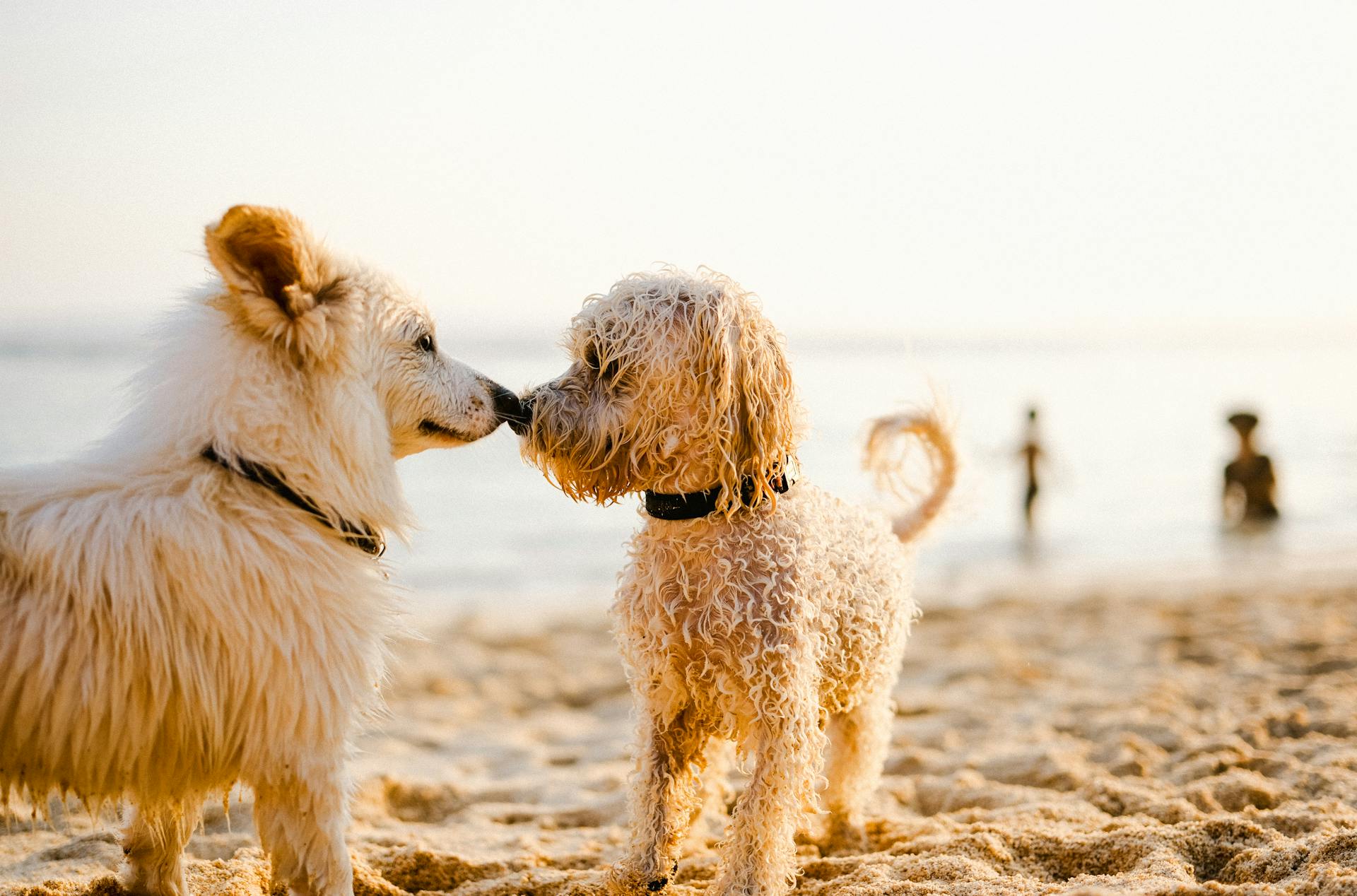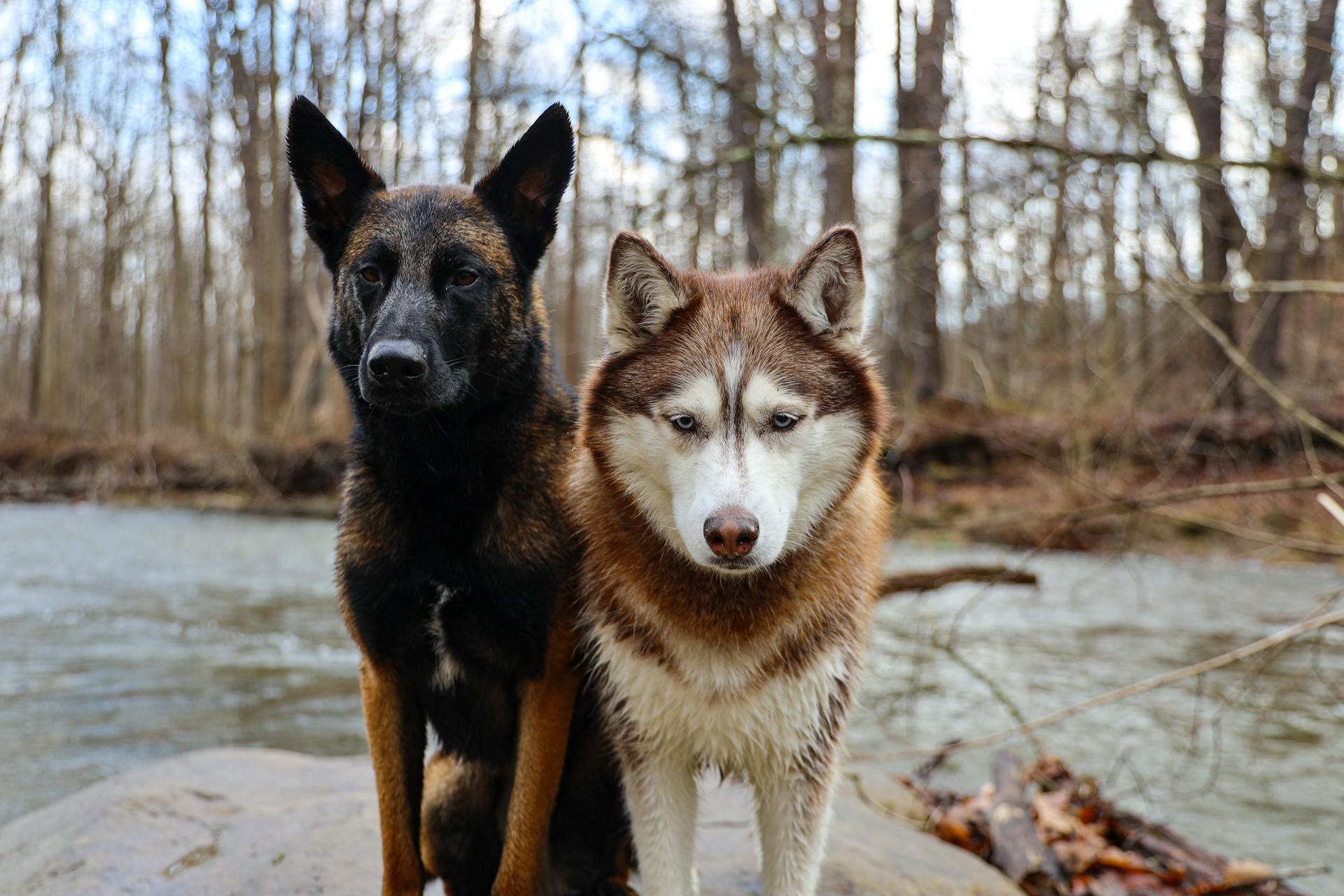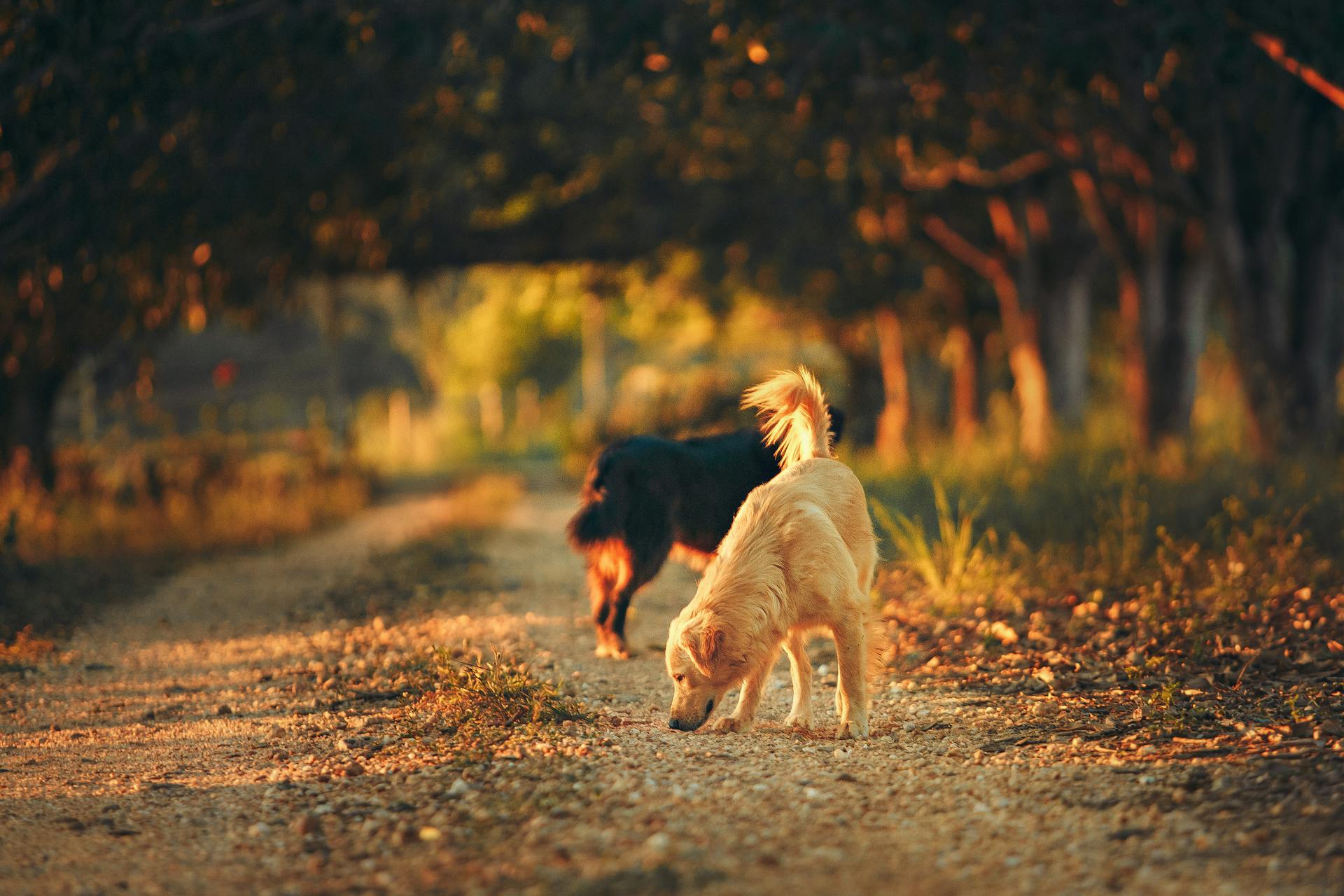
Fear in dogs can be a complex issue, but by recognizing the signs, you can take the first step towards helping your furry friend feel more at ease. One of the most common signs of fear in dogs is avoidance behavior, where they steer clear of situations or stimuli that trigger their anxiety.
A dog's body language can also reveal signs of fear, such as a tucked tail, lowered head, or flattened ears. These physical cues can indicate that your dog is feeling anxious or uneasy. In some cases, a fearful dog may even exhibit aggressive behavior, such as growling or snapping, in an attempt to protect themselves.
Some common causes of fear in dogs include loud noises, new environments, or meeting new people. For example, fireworks or thunderstorms can be incredibly frightening for dogs, leading to intense anxiety and stress. By understanding the underlying causes of your dog's fear, you can develop a plan to help them feel more secure and confident.
Signs of Fear in Dogs
If your dog is scared, it's essential to recognize the signs. Trembling, tail-tucking, and hiding are all common behaviors that indicate your dog is feeling fearful.
Mild fears can manifest in various ways, including reduced activity and passive escape behaviors. If you notice your dog exhibiting these behaviors, it's best to give them some space and let them come to you when they feel more relaxed.
Dilated pupils, a rapid heartbeat, and heavy panting are all physical symptoms that can indicate your dog is scared. These physical signs can be accompanied by behavioral signs, such as panting, pacing, and active escape behavior.
Some common clinical signs of dog anxiety and fear include:
- Mild fears: trembling, tail-tucking, hiding, reduced activity, and passive escape behaviors
- Panic: panting, pacing, active escape behavior, and increased out-of-context motor activity
- Sympathetic autonomic nervous system activity, including diarrhea
- Lesions secondary to licking and biting their own body
- Tail-chasing and circling
Additionally, you may notice your dog exhibiting physical symptoms such as a rapid heartbeat or heavy panting. These symptoms can be accompanied by behavioral signs, such as panting, pacing, and active escape behavior.
Causes and Triggers
Separating a puppy from its mother too early can lead to fear and anxiety in dogs. This is because the mother provides essential socialization and comfort during the critical puppy development phase.
Discover more: Signs of Retained Puppy in Dogs
Some common causes of fear and anxiety in dogs include poor breeding practices, abandonment by previous owners, and trauma from dog attacks. A lack of clarity about their environment, such as their home, can also contribute to anxiety.
Dogs can develop anxiety due to various factors, including loud noises, strange people or animals, and new or unfamiliar environments. Separation anxiety, which affects around 14 percent of dogs, is a significant concern for many pet owners.
Here are some common causes of anxiety in dogs:
- Separation – Dogs are companion animals and often suffer anxiety if left alone for longer than a few minutes.
- Loud Noises – Dogs have very good hearing and can be anxious during storms and when they hear fireworks, loud alarms, or power tools.
- Potential Threats – A potential threat can cause considerable anxiety in your dog, whether it's real or perceived.
- Strange Situations – Dogs need to be socialized from a young age to help them cope with new situations and people.
- Change in Circumstances – Changes in routine, moving house, or changes in your working shifts can all be potential causes of anxiety in dogs.
- Past Experiences – Dogs that have had a bad experience are more likely to suffer anxiety.
Nature vs. Nurture
Research suggests that a combination of genetic and environmental factors contribute to a dog's behavior. Approximately 50% of basic behavior can be attributed to genetic factors, while about 50% can be attributed to learning.
Dogs are born with an innate ability to experience emotions like fear and anxiety, which can be influenced by their environment and upbringing.
A dog's genetic predisposition can play a significant role in their anxiety levels, with some breeds being more prone to anxiety than others.
Here are some common genetic factors that can contribute to a dog's anxiety:
- Poor breeding practices create genetically unsound dogs and psychologically fragile nerves.
- Genetic factors can contribute to a dog's anxiety levels, with some breeds being more prone to anxiety than others.
Environmental factors, such as socialization and upbringing, can also play a significant role in shaping a dog's behavior and anxiety levels.
Proper socialization can prevent the development of anxiety, and introducing your dog to new people, dogs, animals, places, and experiences can help avoid an exaggerated response down the road.
Studies suggest that around 50% of basic behavior is attributed to learning, highlighting the importance of proper training and socialization.
By understanding the interplay between genetic and environmental factors, we can better address the causes and triggers of anxiety in dogs.
Inconsistent Training
Inconsistent training can cause a dog to fear its owner. If the owner is inconsistent with their commands or punishments, the dog may become confused and anxious.
This confusion can lead to anxiety in dogs, making them fearful of their owner's reactions. For example, if the owner allows the dog to jump on them one day but punishes them for it the next, the dog may not understand what is expected of them.

Allowing dogs to jump on us one day and punishing them for it the next can be confusing for them. This inconsistency can cause dogs to become fearful of their owner's reactions, leading to anxiety and confusion.
Consistency is key when training dogs. If owners are inconsistent, they can inadvertently create a fearful dog. Inconsistent training can have long-lasting effects on a dog's behavior and emotional well-being.
Worth a look: Training a Fearful Dog
Treatment and Prevention
If your dog suffers from anxiety, it's essential to talk with your veterinarian to identify the type of anxiety and possible causes. Your veterinarian can also rule out any other medical conditions that could be causing your dog's symptoms.
Your veterinarian will help you come up with a treatment plan that may include a combination of training, preventive strategies, and in some cases, medications. This is because excessive anxiety is often caused by a variety of factors.
Preventing anxiety in dogs can be challenging, but there are ways to help your dog avoid anxiety-related problems. However, it's difficult to predict exactly what will make your dog anxious, and even more difficult to determine if your dog's anxiety will develop into a more serious disorder.
If your dog develops a serious anxiety disorder, your veterinarian may recommend medications or natural therapies. SSRIs and antidepressants, such as fluoxetine and clomipramine, are occasionally prescribed for dogs with anxiety.
See what others are reading: Dog Grooming for Difficult Dogs
Use Positive Reinforcement
Positive reinforcement is a powerful tool for addressing your dog's fear. It involves rewarding your dog for exhibiting positive behavior and ignoring negative behavior.
To use positive reinforcement effectively, you should reward good behavior, such as approaching you without fear, with treats or praise. Consistency is key, so make sure everyone in your household is on the same page and using the same techniques.
You can use positive reinforcement to help your dog associate you with good things, such as treats, toys, or praise. This can be especially helpful if your dog is scared of you or has a history of abuse.
Here are some ways to use positive reinforcement:
- Reward good behavior: When your dog exhibits positive behavior, such as approaching you without fear, reward them with treats or praise.
- Ignore bad behavior: If your dog exhibits negative behavior, such as growling or hiding, ignore it. This will help prevent your dog from associating fear with you.
- Be consistent: Consistency is key when using positive reinforcement. Make sure everyone in your household is on the same page and using the same techniques.
By using positive reinforcement, you can help your dog feel safe and comfortable around you. This can be a game-changer for dogs with anxiety or fear issues.
Prevention
Predicting what will make your dog anxious can be tough, but there are ways to help your furry friend avoid anxiety-related problems.

Identifying triggers is a good starting point, but it's not always easy. It can be difficult to determine if your dog's anxiety will develop into a more serious disorder.
Creating a calm environment is key. It can be as simple as providing a quiet space for your dog to relax.
Regular exercise and mental stimulation can also help reduce anxiety. However, it's essential to tailor your approach to your dog's individual needs.
Exercise and Nutrition
Regular exercise is crucial for a dog's physical and mental well-being. A stimulated dog is less likely to pick up destructive behaviors.
Good nutrition is equally important for your dog's health. Making sure you take care of your dog's physical and mental needs can help you prevent behavior problems.
Managing Fear in Dogs
If you notice your dog is scared of you, it's essential to understand the signs of fear because it helps you know when your furry friend isn't feeling their best. Being there for your dogs when they're scared can make a huge difference in their happiness and trust in you.
Additional reading: Why Do Dogs Attack When They Sense Fear
Give your dog space and let them come to you when they feel more relaxed. This can help them feel safer and more comfortable around you.
Respecting a scared dog's boundaries is crucial, so if they seem uncomfortable or start to back away, give them space and try again later. This will help prevent overwhelming them.
Don't force your dog to interact with you or try to pick them up if they don't want to be touched. Instead, sit or stand near the dog and let them approach you on their own terms.
Dogs can pick up on human emotions, so it's essential to remain calm and confident around a scared dog. Speak in a soft, soothing tone and avoid sudden movements or loud noises that could startle the dog.
If behavior modification exercises don't work over the long-term, your veterinarian may want to modify the approach. It's essential to work with your vet to develop a plan that suits your dog's needs.
Avoid punishment for behavior related to fear, phobia, or anxiety. This can exacerbate the problem and make your dog feel even more anxious.
You might enjoy: Does Beware of Dog Sign Work
Expert Advice and Resources
If a dog is severely scared or has a history of abuse, it's best to seek help from a professional dog trainer or behaviorist. They can provide guidance on how to build trust with the dog.
A professional can help a dog overcome its fears and anxieties, but it's essential to choose someone with experience in canine behavior and training.
Meet Your Experts
Tamsin de la Harpe has nearly two decades of experience working with dogs in rescue, training, and behavior modification, specifically with fearful and aggressive dogs.
She has worked closely with veterinarians and kennels, building up extensive medical knowledge and understanding of canine health and physiology.
Tamsin spent two years researching canine nutrition in the animal sciences, focusing on longevity and holistic healthcare for dogs.
She currently keeps a busy homestead with an assortment of rescue dogs and three Bullmastiffs.
Professional Help
Seeking professional help can be a crucial step in helping your dog overcome their fear. A veterinarian or animal behaviorist can diagnose the cause of your dog's fear and provide guidance on how to address it.

Before seeking professional help, research to find a reputable veterinarian or animal behaviorist in your area. It's essential to find someone trustworthy and knowledgeable.
Follow their advice closely, as they may recommend medication or training techniques to help your dog overcome their fear. Be prepared to put in the effort to help your dog feel safe and comfortable.
Overcoming fear takes time and patience. Don't expect overnight results, and be prepared to work with your dog to build trust and confidence.
Here are some things to keep in mind when seeking professional help:
- Consult with a professional: Research and find a reputable veterinarian or animal behaviorist in your area.
- Follow their advice: Make sure to follow the professional's guidance and recommendations.
- Be patient: Overcoming fear takes time, so be prepared to put in the effort to help your dog feel safe and comfortable.
Sources
- https://pawsafe.com/blogs/dog-behavior/is-my-dog-scared-of-me
- https://happydogtraining.info/behavior/fear-and-anxiety-in-dogs/
- https://www.akc.org/expert-advice/health/treating-dog-anxiety/
- https://www.dogster.com/dog-health-care/anxiety-in-dogs
- https://www.petmd.com/dog/conditions/behavioral/c_dg_fears_phobia_anxiety
Featured Images: pexels.com


